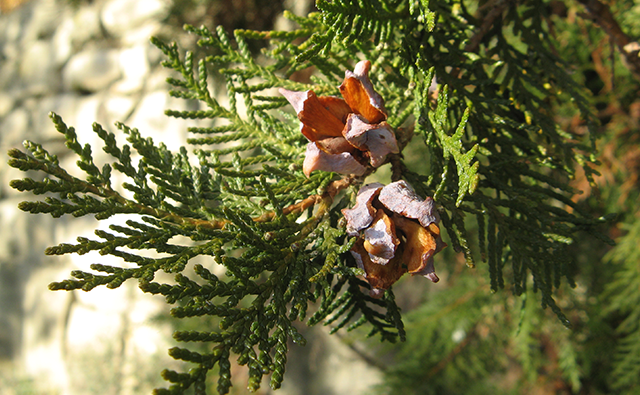Feature Article, Company News, PR
Introduction and Application Prospects of Thujopsene

Feature Article, Company News, PR

Thujopsene (CAS 470-40-6, EC 207-426-8) is a tricyclic sesquiterpene. Basic research shows that Thujopsene is mainly present in the wood of Oriental Arborvitae (Platycladus orientalis), with the highest content reaching 53.01%1. It has a content of 16.955%2 in its roots and 12.843% in its bark. The content in the branches and leaves of Oriental Arborvitae is relatively low. With the increase of the age of Oriental Arborvitae, the content of Thujopsene, Cedrol, Cuparene and other active substances in its wood essential oil is higher2. In plant essential oils with high content of Thujopsene, Cedrol is often rich in them as well. Their mixed essential oils often have traditional medicinal effects.”
Due to the scarcity of high-aged wood, the debris and waste of Oriental Arborvitae can be recycled as a source of raw materials for plant essential oils. Extracting oil from China Fir (Cunninghamia lanceolata) is an alternative method3. China Fir grows fast and has a high yield, with a Thujopsene content of 2.01% in its debris, which can be used as a byproduct for extracting China Fir essential oil. In addition, natural Thujopsene can also be extracted from Sabina chinensis cv. Kaizuca (with a content of 6.90%)4, Phyllostachys heterocycla Pubescens (with a content of 13.88%)5, Sassafras tzumu Hemsl stems (with a content of 9.864%)6, and other plants.
Synthesis of Thujopsene can be achieved using (+)-Dihydrocarvone as the starting material, and the key reaction is the Simmons-Smith cyclopropanation reaction, which produces Dihydromayurone. Thujopsene can then be synthesized in two-process steps7. The synthetic route described above is mainly used for the asymmetric synthesis of Thujopsene-like natural products.
Currently, research on the application of Thujopsene is mainly focused on two areas: the synthesis of fragrances and flavors, and plant protection.
Methyl cedryl ketone is currently one of the main woody fragrance compounds, with a worldwide annual production exceeding 2000t in 20078. Its fragrance characteristics express the aroma of cedarwood while having a level of animal muskiness. This provides a well-coordinated and modified effect on perfumes, cosmetic products, soap fragrances, and other formulations. Its musky characteristic is derived from its main component, Isomer G9.
The production process of commercially available Methyl cedryl ketone was invented by Givaudan. The process uses Cedrene as the starting material and reacts it with acetic anhydride in the presence of a polyphosphoric acid (PPA) catalyst to produce Methyl cedryl ketone10. Another method that is currently being attempted involves synthesizing Methyl cedryl ketone from Thujopsene. First, Thujopsene is isomerized to form Olefin B, which is then acetylated using strong acidic catalysts such as SnCl4 to produce a mixture of Methyl cedryl ketone, mainly composed of Isomer G and Isomer D. Relevant studies show that the final average yield and content of Isomer G using this two-step synthesis process of Methyl cedryl ketone from Thujopsene are about 91.1% and 32.8%, respectively10.
The isomerization pathway of Thujopsene is quite complex, involving both cis- and trans-forms. Under the catalytic conditions of different types of acids, more than ten different isomerization products can be formed through different pathways, including α-Chamigrene, β-Chamigrene, Cuparene, Widrol, Olefin A, Olefin B, Olefin C, Olefin D, Olefin E, Olefin F, and so on11.
Thujopsene undergoes isomerization in the presence of strong acidic catalysts. Using glacial acetic acid, both cis- and trans-Thujopsene can be isomerized to produce 30% α-Chamigrene, 30% β-Chamigrene, and 40% Olefin C. Under stronger acidic conditions, such as using high chloric acid, the isomerization products of cis- and trans-Thujopsene are mainly Olefin C, which can be further transformed into Olefin A and Olefin B11. Solid superacid TiO2/SO4 can also be used as a catalyst. In addition, other catalysts that can be used include C-acylation reaction, polymer acidic catalysts, heteropoly acid (HPA) catalysts, zeolite catalysts, supported catalysts, metal catalysts, etc.11
Chemical information substances are an important mechanism for attracting or repelling pests. The application of Thujopsene as an attractant for Anoplophora glabripennis and Dendrolimus superans has confirmed the attraction or repulsion effect of plant extracts on pests. Similarly, Thujopsene plays a critical role in the aggregation of Phloeosinus perlatus Chapius. Volatile oil components extracted from weakened Platycladus orientalis bark were analyzed, and the mass fraction of Thujopsene increased to 40.29%, while the mass fraction of Thujopsene decreased to 18.09% in weakened heartwood. In healthy Platycladus orientalis bark, Thujopsene accounts for about 12.843%1, which increases threefold in weakened states. In experiments using volatile oils extracted from Platycladus orientalis heartwood as an attractant13, the number of attracted Platycladus orientalis woodborers was three times higher in the experimental group than in the control group. It has also been demonstrated that the attractant has a strong lethal effect on adult pests.
In addition to Phloeosinus perlatus Chapius, Thujopsene also has a significant effect on attracting other pests such as Semanotus bifasciatus Motschuisky, Blastophagus piniperda L., and Chrysopa septempunctata Wesmael..
Oriental Arborvitae volatile oil also has antibacterial effects14. It has been shown to have inhibitory effects on bacteria such as Staphylococcus aureus and Escherichia coli. Through experiments, it was found that ethyl acetate extracts of heartwood rich in Thujopsene had good antimicrobial effects on white rot fungus (Ipex lactenus), brown rot fungus (Gloeophyllus trabeum), and Aspergillus niger, especially on brown rot fungus14. The above antibacterial effects have also been confirmed in experiments using Cupressus funebris sawdust volatile oil against Salmonella15. Cupressus funebris Endl. sawdust contains about 18.25% Thujopsene, while α-Cedrene and Cedrol are the main volatile oil components in the sawdust. It was found through experiments that the antibacterial effects of these components against Salmonella and Bacillus subtilis were stronger than that of erythromycin15.
The current application of Thujopsene is being promoted, often found in plant volatile oils along with Cedrol or Cedaryl alcohol. Such plant volatile oils also have certain medicinal value. Thujopsene is an important precursor for the synthesis of Methyl cedryl ketone when used alone, and its isomerization products have strong business value.